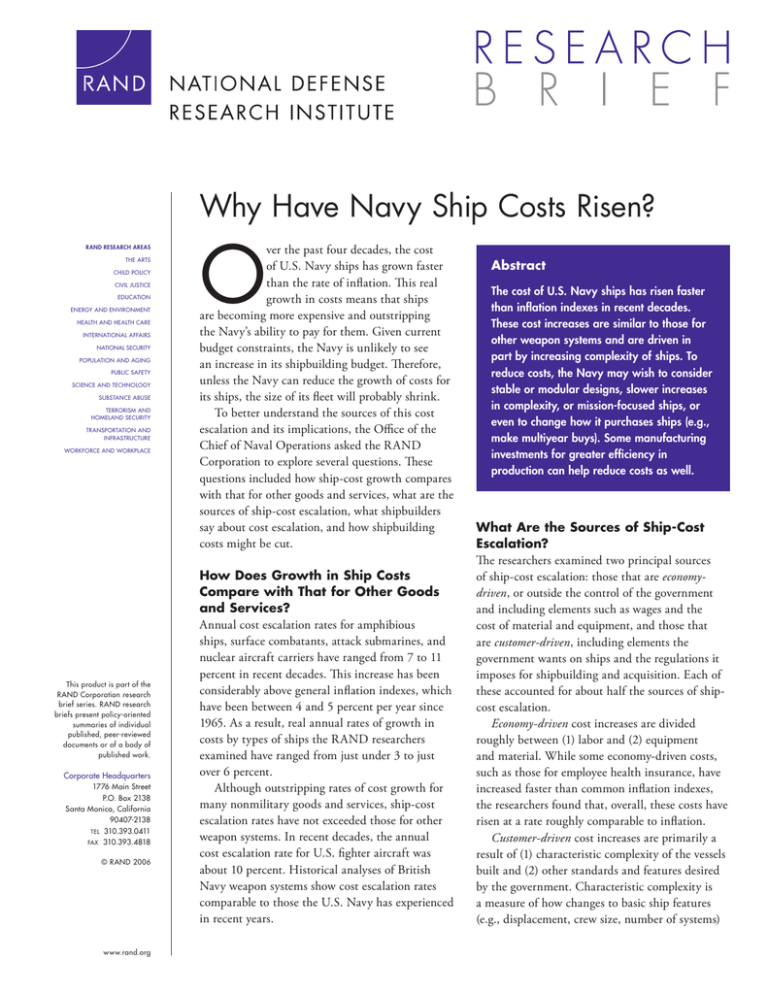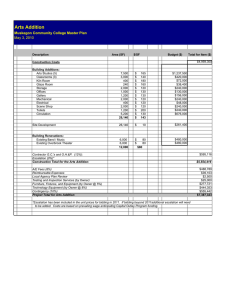O Why Have Navy Ship Costs Risen?
advertisement

Why Have Navy Ship Costs Risen? RAND RESEARCH AREAS THE ARTS CHILD POLICY CIVIL JUSTICE EDUCATION ENERGY AND ENVIRONMENT HEALTH AND HEALTH CARE INTERNATIONAL AFFAIRS NATIONAL SECURITY POPULATION AND AGING PUBLIC SAFETY SCIENCE AND TECHNOLOGY SUBSTANCE ABUSE TERRORISM AND HOMELAND SECURITY TRANSPORTATION AND INFRASTRUCTURE WORKFORCE AND WORKPLACE This product is part of the RAND Corporation research brief series. RAND research briefs present policy-oriented summaries of individual published, peer-reviewed documents or of a body of published work. Corporate Headquarters 1776 Main Street P.O. Box 2138 Santa Monica, California 90407-2138 TEL 310.393.0411 FAX 310.393.4818 © RAND 2006 www.rand.org O ver the past four decades, the cost of U.S. Navy ships has grown faster than the rate of inflation. This real growth in costs means that ships are becoming more expensive and outstripping the Navy’s ability to pay for them. Given current budget constraints, the Navy is unlikely to see an increase in its shipbuilding budget. Therefore, unless the Navy can reduce the growth of costs for its ships, the size of its fleet will probably shrink. To better understand the sources of this cost escalation and its implications, the Office of the Chief of Naval Operations asked the RAND Corporation to explore several questions. These questions included how ship-cost growth compares with that for other goods and services, what are the sources of ship-cost escalation, what shipbuilders say about cost escalation, and how shipbuilding costs might be cut. How Does Growth in Ship Costs Compare with That for Other Goods and Services? Annual cost escalation rates for amphibious ships, surface combatants, attack submarines, and nuclear aircraft carriers have ranged from 7 to 11 percent in recent decades. This increase has been considerably above general inflation indexes, which have been between 4 and 5 percent per year since 1965. As a result, real annual rates of growth in costs by types of ships the RAND researchers examined have ranged from just under 3 to just over 6 percent. Although outstripping rates of cost growth for many nonmilitary goods and services, ship-cost escalation rates have not exceeded those for other weapon systems. In recent decades, the annual cost escalation rate for U.S. fighter aircraft was about 10 percent. Historical analyses of British Navy weapon systems show cost escalation rates comparable to those the U.S. Navy has experienced in recent years. Abstract The cost of U.S. Navy ships has risen faster than inflation indexes in recent decades. These cost increases are similar to those for other weapon systems and are driven in part by increasing complexity of ships. To reduce costs, the Navy may wish to consider stable or modular designs, slower increases in complexity, or mission-focused ships, or even to change how it purchases ships (e.g., make multiyear buys). Some manufacturing investments for greater efficiency in production can help reduce costs as well. What Are the Sources of Ship-Cost Escalation? The researchers examined two principal sources of ship-cost escalation: those that are economydriven, or outside the control of the government and including elements such as wages and the cost of material and equipment, and those that are customer-driven, including elements the government wants on ships and the regulations it imposes for shipbuilding and acquisition. Each of these accounted for about half the sources of shipcost escalation. Economy-driven cost increases are divided roughly between (1) labor and (2) equipment and material. While some economy-driven costs, such as those for employee health insurance, have increased faster than common inflation indexes, the researchers found that, overall, these costs have risen at a rate roughly comparable to inflation. Customer-driven cost increases are primarily a result of (1) characteristic complexity of the vessels built and (2) other standards and features desired by the government. Characteristic complexity is a measure of how changes to basic ship features (e.g., displacement, crew size, number of systems) make them more difficult to increase. The researchers found that increases in light ship weight (LSW) and power density (i.e., the ratio of power generation capacity to LSW) correlated most strongly with ship costs. Changes in these variables by themselves likely do not lead to increased ship costs. Instead, they indicate other changes that do tend to increase costs. Power density, for example, is related to the number of mission systems on a ship. Overall, the Navy’s desire for larger and more-complex ships has been a significant cause of ship-cost escalation. Other standards and features, such as desired improvements in survivability, habitability, working conditions both onboard and in constructing ships, and environmental regulations surrounding the construction and operation of ships, have also contributed to ship costs. Procurement rates contributed a smaller portion to overall cost escalation. Figure 1 illustrates the contributions of different factors to the 9.2 annual rate of cost growth seen in constructing guided missile destroyers between 1961 and 2002. shipyards, the government is the main, if not only, customer. Fluctuating ship orders, with initially forecast orders typically exceeding what is ultimately purchased, discourage shipyards from making investments that could ultimately reduce the cost of ships. An unstable business base also causes fluctuations in the demand for skilled labor that are expensive and difficult to manage and prevents contractors from leveraging through long-term contracts purchases from subcontracting suppliers. Decreasing production rates tend to increase overhead rates and make the shipbuilders and their suppliers produce at lower efficiency. What Can Be Done to Reduce Ship Costs? To counter increasing costs, the Navy can target some of the main factors related to cost escalation, such as those related to capability and complexity of the vessels. Where the Navy has produced a class with a relatively stable design, the cost changes within that class have stayed in line with inflation. Another approach would be to reconsider the mission of ship classes. Rather than building large, multi-mission ships, the Navy could build smaller, mission-focused ships, thereby constraining requirements growth and reducing the cost of any single hull. A third approach would be to separate the mission and weapon systems from the ship, similar to the modular approach currently being pursued with the Littoral Combat Ship. There are also some areas in which shipbuilders might be able to reduce costs. Some investment initiatives, such as those for lean manufacturing, could improve efficiency. Unfortunately, traditional defense contracting approaches have not provided adequate incentives for shipyards to invest in such techniques. Another potential area for reduction is indirect costs, which have grown faster than inflation, but such reductions would target only the labor portion of the escalation, which accounts for less than a quarter of overall escalation. Still other approaches would address program management or acquisition strategy—that is, the way ships are purchased. The government could, for example, use longer-term contracts or multiyear buys to add some stability to production demand. The Navy could also reduce change orders. Still other steps, such as rationalization of shipbuilding capacity or the involvement of foreign competition, could also help reduce shipbuilding costs, but these are less politically palatable. Rationalization of shipbuilding capacity or concentration of manufacturing to realize greater efficiencies, for example, could lead to some shipyard closures. Figure 1 Contributions of Different Factors to Shipbuilding Cost Escalation for Surface Combatants: DDG-2 (Fiscal Year 1961) and DDG-51 (Fiscal Year 2002) Rate 0.3% Material 0.5% Standards and requirements 2.0% Equipment 2.0% Complexity 2.1% Labor 2.0% Other 0.3% What Do Shipbuilders Say About Cost Escalation? In addition to quantifying sources of cost escalation, the researchers asked shipbuilders for their views on why such escalation occurs. The most common explanation shipbuilders offered related to an unstable business base and decreasing production rates. For many This research brief describes work done for the RAND National Defense Research Institute documented in Why Has the Cost of Navy Ships Risen? A Macroscopic Examination of the Trends in U.S. Naval Ship Costs Over the Past Several Decades, Mark V. Arena, Irv Blickstein, Obaid Younossi, and Clifford A. Grammich, MG-484-NAVY, 2006, 122 pages, $20.00, ISBN: 0-8330-3921-0, available at http://www.rand.org/pubs/monographs/MG484/. The RAND Corporation is a nonprofit research organization providing objective analysis and effective solutions that address the challenges facing the public and private sectors around the world. RAND’s publications do not necessarily reflect the opinions of its research clients and sponsors. R® is a registered trademark. RAND Offices Santa Monica, CA RB-9182-NAVY (2006) • Washington, DC • Pittsburgh, PA • Jackson, MS • Doha, QA • Berlin, DE • Cambridge, UK • Leiden, NL THE ARTS CHILD POLICY This PDF document was made available from www.rand.org as a public service of the RAND Corporation. CIVIL JUSTICE EDUCATION ENERGY AND ENVIRONMENT HEALTH AND HEALTH CARE INTERNATIONAL AFFAIRS NATIONAL SECURITY This product is part of the RAND Corporation research brief series. RAND research briefs present policy-oriented summaries of individual published, peerreviewed documents or of a body of published work. POPULATION AND AGING PUBLIC SAFETY SCIENCE AND TECHNOLOGY SUBSTANCE ABUSE TERRORISM AND HOMELAND SECURITY TRANSPORTATION AND INFRASTRUCTURE The RAND Corporation is a nonprofit research organization providing objective analysis and effective solutions that address the challenges facing the public and private sectors around the world. WORKFORCE AND WORKPLACE Support RAND Browse Books & Publications Make a charitable contribution For More Information Visit RAND at www.rand.org Explore RAND National Defense Research Institute View document details Limited Electronic Distribution Rights This document and trademark(s) contained herein are protected by law as indicated in a notice appearing later in this work. This electronic representation of RAND intellectual property is provided for noncommercial use only. Permission is required from RAND to reproduce, or reuse in another form, any of our research documents for commercial use.






